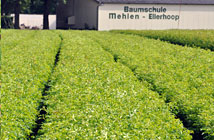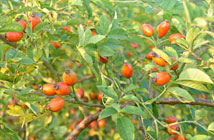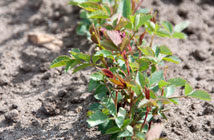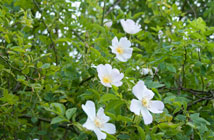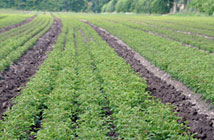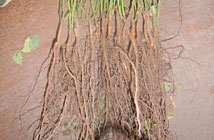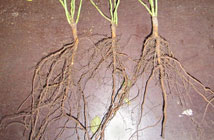Rose rootstocks
Today's rose rootstocks have their origin...
...in the wild roses and have been further improved through breeding and selection in order to be more useful and practical for rose propagation by bud or winter hand grafting.
Attention should also be paid to the compatibility of the scion with the wildling. The most common rootstocks are: Rosa canina Inermis, Rosa canina Pfänder, Rosa canina Pollmeriana/Pollmeriana Schreiber, Rosa corymbifera Laxa and Rosa multi flora. Special selections from the individual species are also available.
-
Rosa canina Inermis
Belongs to the oldest rootstocks, is almost without thorns, very fast-growing and characterised by a long grafting period. It is compatible with most rose species and produces long stalks and vivid colours in the cut flowers. Some varieties tend to produce wild shoots. -
Rosa canina Pfänder
Has a very attractively branched, fibrous root form and is thus also suitable for light soils. It is compatible with most rose varieties and is relatively robust against frost. The stock is often used for climbing roses and to form stems. This wild rose is susceptible to mildew and tends to produce wild shoots. The grafting period is somewhat shorter than with Inermis. -
Rosa canina Pollmeriana/Pollmeriana Schreiber
Loves heavy soils and warm temperatures, but also survives dry periods and heavy frosts. The stock is compatible with most cultivated varieties and is also suitable for forcing. Pollmeriana Schreiber is predominantly thornless and forms attractive but slender stems. The species produces few wild shoots but is rather susceptible to rust and downy mildew. Finishes growing early. -
Rosa corymbifera Laxa
Is the most commonly used rootstock for bedding roses. It has few thorns, thickens fast, has very short growth and long root necks. The wild plant is well compatible with almost all cultivated varieties and produces very few wild shoots. It does however demand good soil and is susceptible to soil fatigue. The grafting period is early and short. Susceptible to downy mildew and rust. -
Rosa multi flora
Is very strongly growing and rapidly produces the qualities of true roses. The rootstock has a very good root system and is also well suited for light locations. The compatibility with most other cultivated varieties is good and the grafting period long. The rootstock is relatively susceptible to frost, but also common in Scandinavia. The colouring is rather weak and attention should be paid to the risk of wind damage. -
Weitere Veredlungsunterlagen sind
Rosa canina 'Brögs', Rosa canina 'Schmidts Ideal', Rosa canina 'Heinsohns Rekord', Rosa rubiginosa and the simple Rosa canina. These species have however largely disappeared from the market due to their poorly balanced properties and are only rootstocks for specialist.




